
Aug 21, 2020 | BUSINESS SUPPORT
Ensuring Compliance is being met with Companies House
Ensuring compliance is being met with Companies House is one of the most important things you need to complete. Starting your own business brings a tidal wave of emotion and in the early stages there are many key decisions for you to make. One of the biggest decisions you need to make is to decide whether to be a Sole Trader or Limited Company.
I once had a client who had decided to become a Limited Company but had not completed all the necessary legal requirements. This blog post is for other new businesses who may be in the same position.
Overview
- What does having a limited company mean?
- What is Companies House?
- Why do you need to register with Companies House?
- What do you need to do to ensure you are compliant?
- Information that should be submitted.
- What can Companies House do for you?
- Conclusion
- How Busy Lives! can support you with this
What does having a Limited Company mean?
- A Limited Company is legally separate from the people who run it.
- It has separate finances form your personal ones.
- You can keep any profits your company makes after paying tax.
- Incorporation with Companies House is the term used when you set up the private limited company with Companies House.
What is Companies House?
Companies House is a government run service. Its responsibilities are to ‘incorporate and dissolve limited companies…register company information and make it available to the public’ (Gov.uk, 2020).
Companies House has four offices in the UK: Cardiff, Edinburgh, Belfast, and London. However, all their services are available online. When registering your company be sure to register with the correct office. Cardiff for England and Wales, Belfast for Northern Ireland, and Edinburgh for Scotland.
Why do you need to register with Companies House?
All limited companies (a business that is a company in its own right) and limited liability partnership (LLPs) are legally required to register with Companies House.
What do you need to do to ensure you are compliant?
When setting up a limited company you must register with Companies House. Where your business is located will determine which of its branches you will be dealing with.
Important to Note:
Your company can operate in multiple UK jurisdictions, but the office address must remain in the area you registered it. For example, a company registered in Scotland can operate in Wales, but the home office must stay in Scotland.
Information that should be submitted
- Company name.
- The correct address for the company. This can also be registered as a correspondence address through your accountant if you don’t wish the general public having access to your home address.
- Name of who the Director/s.
- Details of your Companies shares – you need to have at least one shareholder.
- When you register a company you need to provide information about the shares which is known as a ‘Statement of Capital.’
- All shareholders names and addresses should be given. Shareholders are technically known as ‘Members.’
- If you have shareholders other than yourself you also must then have ‘prescribed particulars’ for them.
- A SIC code needs to be in place. This means Standard Industrial Classification. This identifies what your company does.
- Memorandum of Association.
- Articles of Association.
- PSC which is details of People with Significant Control.
- As the company director you are legally responsible to ensure the company accounts and reports are properly prepared. Many businesses use their Accountant to do this on their behalf.
- You should be registered for Corporation tax and PAYE as an employee at the same time as registering with company’s house within three months. You may get a penalty fee if this is not done within this period.
Top Tip
Once you have registered with Companies House you must ensure you keep them up to date with any changes to your company this includes:
- Appointing new directors / secretaries and changes to your PSC’s.
- Changing your company name.
- Changing your registered office’s address.
- Changes to your accounting reference date.
- Changes to your share information – i.e. if you sell more shares.
- Any mortgage information.
What can Companies House do for you?
- As well as documenting all limited companies, Companies House is responsible for keeping all data up to date and removing / prosecuting non-compliant companies. You can use Companies House to file documents online using their software. Completing documents online is often easier than filling in paper forms. As well as giving data you can also download data from their website.
- Another important service provided by Companies House is the ability to search for disqualified directors and information on other companies, this could include your company’s competition!
- Companies House has protected online filing meaning your company is protected from fraudulent changes to its records.
- You can also sign up for ‘Follow’. This is a free service that alerts you of company transactions, including what has been filed and accepted by Companies House.
- Companies House also allows you access copies of certified documents held on their register and certificates of incorporation with certified facts.
Conclusion
Registering with Companies House can be pain-free process provided you gather all the required information beforehand – you will need 3 pieces of personal information about you and your shareholders / guarantors (for example, national insurance number, passport number, town of birth or parent’s names).
Once you are registered don’t forget you will need to keep you Companies House records up to date, which is available to do online.
How Busy Lives! can support you with this
Busy Lives! was created when I left a busy career that left me time poor and unable to give sufficient priority to what really mattered to me. I now provide a wide range of business support for people in that position.
I am happy to help by checking your paperwork is all accurate, up to date and submitted with companies house.
Busy Lives! relevant links to this blog post:
- Business support for the running of your business. https://bit.ly/2sLMt7E
- Small business support case study. https://bit.ly/36cTYSJ
Let you help you gain precious time back. Ring Busy Lives! 07565 722 031
Drop me a message on this website, LinkedIn or Messenger on Facebook
Or Email: karen@busylivesnottingham.co.uk


Jul 21, 2020 | BUSINESS SUPPORT
Key Components for Writing a Business Plan When Starting in Business
The two activities which gave me the best preparation possible for the launch of Busy Lives! were attending a three-day course on starting your own business and writing a business plan. I knew exactly what my services were going to be, but I had not considered the entire big picture and everything else that was needed. Writing my business plan gave me not only an insight as to what was required but clarity and understanding of what my business would achieve within a competitive marketplace.
Writing a business plan enables you to have a robust strategy for moving forward. If you are in the process of starting your own business or at a stage in your business where you require a business plan, I hope the contents of this blog post give you a good starting point.
Overview
- Why do you need a business plan?
- When should you make a business plan?
- Key components of a business plan
- Final Top Tips
- How Busy Lives! can support you with this
Why do you need a business plan?
Whatever your business, a business plan is essential. It will allow you to strategically break down all the necessary elements involved in running a business and allow you to see if your business will succeed. It is also a crucial document to have if you are applying for a grant or a loan.
An effective business plan will outline your business structure and future goals. This can also help secure potential lenders and business partners. Having a strong business plan can show potential lenders what to expect from your business and help them decide if your business is worth investing in.
As well as drawing in outsiders, your business plan is a tool you can use to create a blueprint of what your business is going to achieve. This is especially helpful when you are starting out.
When should you make a business plan?
It is advisable to create your business plan before leaving your current career. A well-thought out business plan can help you make sure you are really ready.
Update your plan regularly, to ensure your business continues to grow and this is a ‘living document.’ – I update mine every 6 or 12 months.
Key components of a business plan
Below are key parts of a business plan. Not every business will require every section. Take the time to read through and decide if you need this. And remember, you can always add and remove sections as your business grows and changes.
Depending on your business, your business plan can take many forms, for example a small one-person business plan may focus on personal goals for development, target customers and finances.
Front Page
Use this to provide key snap shot information about your business.
Include your:
- Your brand logo
- Contact name
- Business name
- Address
- Post code
- Telephone
- Email
- Website
- Business idea
- Start date
- Business structure
- Last updated
Table of contents
- A table of contents is a useful guide for the reader. It shows the different parts of the business plan which can be quickly referenced by page number and demonstrates your thought process in compiling it logically.
Executive summary
- This section should be at the start of your business and plan. The executive summary outlines what your business is going to accomplish.
- This section can also include your business’ mission statement and what services / products your business is going to provide.
- If you are applying for funding / finance this is the place to detail what you want. In general, you should keep this section to half a page but no more than a full page.
- If your business is already established this section can detail what you have already achieved and how you are planning to move forward.
Top tips
- You should consider at your executive summary as your ‘elevator pitch’. It needs to be short and to the point.
- Write your executive summary after you have written the rest of your plan. Your executive summary should be a condensed form of your business plan so writing it last can make sure you have included all the important points.
Business description
- This is where you write your business description. Include key information such as your business’ goals and what makes your business stand out from the crowd. (Once you are established, you can include your business’ history).
- One of the most important things to include in your business description is your mission statement. A mission statement should be short and clearly display your unique selling point. For example: if your business focuses on environmental issues make sure your mission statement incorporates this.
Top tips
- Your business goals should be SMART (Specific, Measurable, Achievable, Related Targets). Vague goals can negatively impact on your direction moving forward and profits.
- When writing your business’ history do not record everything. Stick to major milestones and basic information.
Management and organisation
- This section is for you to outline your business’ chain of command. This can be a diagram or a list detailing high-profile people / outsourced business and their skills / job responsibilities.
- This is also the place to state whether your business is a limited company, sole-trader, or partnership.
Top tip
- Detailing the skills and experience of important people in your business can entice investors. A business with lots of skilled and experience people is less of an investment risk.
Legal Matters
When setting up a business you must ensure you adhere to all legalities such as:
- Making sure you have the required insurance, permits, licences or registrations.
- You adhere to H&S guidelines and practices.
- Your business complies with current GDPR regulations (data protection).
Breakdown of products and services
- Detail your business’ products and services stating how these will meet an existing or future need in the marketplace.
Top tip
- As well as pointing out the features of your products / services ensure you state how these features benefit your customers.
Market analysis
- This is your opportunity to showcase your knowledge of your industry. Use statistics and dates to prove your points and state where your business will sit in this industry. This also be the place to detail the demographics of the customers you market to. Include your sale forecasts and market strategy.
- Use your research to detail why your business is going to be profitable. For example: online searches for the product / service your business provides have increased by X % over the last X months.
Top tip
- When deciding your target customers aim to be as specific as you can. Your marketing should be pitched as if you are talking directly to them.
Marketing plan
- Your marketing plan should detail the steps you are going to take to promote your business. You can also include your planned budget for this. There are several things you should include in this section including:
Marketing Strategy
- Detail what current strategies you have in place and where you intend to get most of your business from. For example: word of mouth referrals. From this you can detail how you are going to move forwards and increase your sales either by implementing new marketing plans or building on existing ones.
Market Analysis
- A market analysis is where you conduct research into your business’ market. This includes discovering who your potential customers are and what their shopping habits are. How much your customers are willing to pay for something and how large your target market is.
Geographical Segmentation
- This is a strategy where you either serve customers in a particular area only or where your customers will have different preferences based on their geographical location.
- If geographical segmentation is applicable to your business then here is the place to document this and group your customers based on location; this can be done by region, city or neighbourhood.
Demographical and Behavioural Segmentation
- Demographical segmentation is where you divide your customers based on their demographics. This can include age, gender, income, location, education and ethnicity.
- For example, a budget gardening business may choose to focus on customers with lower incomes.
- Behavioural segmentation requires you to know more about your customers habits including their spending habits and brand interactions.
- For example a budget car business may decide to focus on customers who have purchased a second-hand car in the past five years.
Competitor Analysis
- This is really key to not only know who your competitors are but ensure you pitch your pricing accurately. Here you need to compare your business to those that already exist. Map out your competitor’s strengths and weakness and how their business differs.
- Reflect how you can benefit from their weaknesses to make a success of yours.

SWOT Analysis
- This is a really important section to spend time on. Break down the different aspects of your business and you running it. Doing this will help you to identify where you need to professionally develop or outsource parts of your business to in the future.
- Whenever you identify a weakness you need to find a solution.
- Lastly, when you have mapped this out. Prioritise which identified weaknesses and threats need to be tackled in the short or long term.

Pricing
- Use your competitor analysis with what they are charging on average as a starting point.
- Pricing is an important element and will have a direct impact on your business. When pricing your products / services it is important to cover all your costs – this includes materials, labour, property, marketing, networking, distribution costs and a monthly salary.
- Don’t forget to factor in Tax and National Insurance.
Top Tip
- Check your pricing against the number of hours you intend to work each week across a whole year. Is it still financially viable? You may find you need to adjust what you charge in light of this.
Funding
- If you are trying to get funding it is a good idea to include a funding section which plainly states how much money you are looking for and how you are going to use it. If you are going to need more money later, state that too.
- If you do not have an exact number in mind provide a range. For example: £2,000.00 -£3,000.00
- It a good idea to include a timeline showing investors what they can expect from your business.
Top tips
- Make sure your funding request is realistic.
- Demonstrate ‘Best Value’ where you can obtaining three quotes on equipment and resources.
- Low investments with high returns are more desirable than high investments with low returns.
Finances
- This is the place to plan out your business’ financial goals and your expectations based on your research. State your estimated revenue for the upcoming year.
- This is also the place to make a budget. For new businesses you need to research your estimated costs and how you will budget for them. If you are unsure of a cost always budget more to make sure you are not left short.
- It is also vital for you to consider and include your own living costs. As a business owner your monthly income is not guaranteed, especially when you are starting out. This is something you will need to factor in and budget for before starting your new business venture.
- For a new business, you will need to do a personal balance sheet and a projection of your business’ balance sheet. When making these make sure you remain realistic and work both best-case and worst-case scenarios. Remember to consider your living expenses and ensure you have budgeted for this.
Top tip
- Have two financial figures. A realistic one for what you need to earn as a minimum to meet your expenditure including your cost of living. The second one is your financial goal that you aim to achieve.
- When writing your income and cash flow statements your first year should be broken down to monthly segments, your second year can be quarterly and thereafter it can be yearly.
Appendix of official documents
- One final thing you may require is an appendix of related documents. This can include permits, certificates and legal documents as well as industry memberships and identification numbers.
Final top tips
- Less is more. Keep your business plan to the point.
- Make it easy to read. Investors receive countless business plans. If it is hard to read, they will not read it.
- Make it professional. Ensure you proofread the document and lay it out in a clear and professional, consistently formatted manner.
Not every business will require everything detailed above. Use what you find useful and tailor you plan to suit your needs.
When you do revisit your plan, you will most likely find that you have achieved some goals and so sections of your plan are no longer relevant. This is a good thing and shows your business has progressed. It also means it is time for you to set new goals. However, you may also find you have not achieved some goals. If this is the case then sit down and find out why you have not reached this goal, adjust it if needed and plan is needed to be put in place for it to succeed.
How Busy Lives! can support you with this
Busy Lives! was created when I left a busy career that left me time poor and unable to give sufficient priority to what really mattered to me. I now provide a wide range of business support for people in that position or are wanting to start their own business.
I am happy to help by:
- Discussing the content with needed for writing a business plan for your business.
- Working alongside you to help you write your business plan.
- Listening to your ideas and content then typing your business plan for you.
- Formatting your business plan so that it looks of a high professional standard.
- Researching your competitors for the competitor analysis section of your business plan.
- Sharing the business plan template that I use.
Find out more about my Business Support Services
Let you help you gain precious time back. Ring Busy Lives! 07565 722 031
Drop me a message on this website, LinkedIn or Messenger on Facebook
Or Email: karen@busylivesnottingham.co.uk


Jun 21, 2020 | BUSINESS SUPPORT
That was then, this is now. The brand story behind Busy Lives!
From being a well-known School Leader to becoming an unknown Businesswoman – the values and tools that brought me through this transition.
Overview
- A change in direction
- A new beginning…know, like and trust
- Gaining new clients who previously didn’t know me
- Why?
- How?
- What?
- Key messages
A change in direction
How does taking your career in a new direction change your core values or modus operandi?
…‘What lies behind us and before us matters little compared to what lies within us.’…
O Wendel Holmes
I stumbled across this quote some years ago at one of the Transformational Leadership courses that I attended in my previous role of a Head Teacher. As the facilitator used it as his ‘Key message’ at the end of Day One, and we had to go away and reflect upon this. To me it seemed simple, why would your values change just because your job title changed?
Two years ago I left my Head Teacher role, leading approximately one hundred and fifty staff and seven hundred and fifty children, to start a new career path as I had always planned to at the age of fifty. I want to share with you the thoughts of past colleagues and recent clients’ feedback that will exemplify how successfully I have transitioned my values into my new role.
As a complete unknown in the business world, I asked my previous colleagues and contacts within the education section to provide me with some testimonials that would help new potential clients gain an insight into who I am and how I work. Here are a few samples of what they said:
“She is logical, methodical and organised and has an excellent eye for detail. Karen looks for creative and practical solutions to problems and works efficiently to put them in place. Any tasks she undertakes will be carried out to the highest standards.”
“The growth of a school is a great undertaking and Karen demonstrated a very strategic approach in her thinking and planning. Efficiency and effectiveness are key aspects of Karen’s professional role and she is committed to supporting others in order to manage their lives.”
“She is very good at analysing challenging problems and situations accurately, finding solutions and bringing order to them systematically. Her attention to detail is exceptional and all her work is carried out to a very high professional standard.”
As a Head teacher your values and how you implement them are highly exposed and visible to everyone. In my new career, I was shifting the emphasis of my role onto supporting and adding value to other people, to help transform and develop their businesses.
A new beginning…Know, Like and Trust.
…‘Though my principles are not many, I am very loyal to every one of them’…
Sameh Elsayed
The above quote is something that I passionately believe in and have used to build my brand. From attending NBV small business courses I was introduced to the concept of developing your brand strategy using the simple mantra of ‘know, like and trust.’
This resonated powerfully with my own way of thinking and I set about creating a business plan using it.
My core strategy was to build my brand story through:
- The ongoing development of a website that exemplified the ‘who and why’ that is continuously reviewed and updated, so that it is a living document of my values and the impact that I have on my clients’ businesses.
- Regular attendance at networking events allied to informal meetings with other attendees in order to develop potentially supportive relationship and gain an insight into the needs of my peers.
- Using multiple social media platforms to communicate my brand values and promoting the businesses of my peers in a systematic way.
I was successful at accessing funding from Broxtowe Borough Council which allowed me the opportunity to access the services of a marketing professional who provided me with their expertise and guidance over time to enable me to grow the brand story efficiently and systematically.
As I began to implement my strategies, my initial clients provided me with feedback as to how my way of working impacted on them and their businesses:
“Her attention to detail and clarity of thought adds helpful dimensions for those who have busy lives and need a wise hand to guide them behind the scenes.”
“Karen has always been highly professional with a human touch, very efficient yet has a great sense of humour.”
“Integrity, honesty and professionalism are key values that Karen will bring to any organisation as well as being very loyal and hard working.”
To be honest, some of these clients I have had some brief contact with in the past and were therefore more inclined to use my business services, but my impact on their businesses still stands.
Gaining new clients who previously didn’t know me – How?
…‘Good values are like a magnet, they attract good people.’
John Wooden
As part of my annual review, I invited five of my clients that I have worked with in the previous twelve months to fill in a questionnaire that would provide me with useful feedback as to how I was attracting clients, what they specifically wanted me to achieve on their behalf and the impact I had on them and their business.
These five businesses operate in a wide range of sectors: Car Bodywork Repair Specialist, Coaching, Creative Arts, Marketing and Mediation.
All of these businesses have used my services at different times of the year on a regular basis. All of these clients possess ‘good’ values and a high degree of professionalism – exemplified by the time they took to help and support my growth through filling in my questionnaire.
I have organised their feedback into three key areas:
- Why did they choose to use Busy Lives!
- How Busy Lives! services were used.
- What impact did Busy Lives! have on them and their business.
Why?
“I prefer to deal with people I know and very importantly trust. Having met Karen at Network meetings I felt there was an opportunity for Karen to support me with my business.”
Liam Kelly – Ready for Retail
“Having heard about your reputation in Education (and worked with you briefly in that role), plus the way you talk so confidently and passionately about the business support that you would offer.”
Debbie Inglis – Debbie Inglis Associates
“Immediately felt warmth, came across as highly knowledgeable, could relate to me and my business which meant that I felt I could trust her – all from a single meeting at a networking event.
Rebecca Hart – Dance Equation
“What I saw at networking was reflected exactly in your social media. You have a very strong work ethos and ethics. I could see you have a passion for helping people and a high level of knowledge and expertise.”
Claire Taylor – Creationz Marketing
“Your personable approach and your organisational skills were clear when you presented at networking events.”
Pete Colby – Pragmatism (UK) ltd.
How ?
“I outsourced Karen to deal with administrative, yet sensitive issues related to financial matters that were necessary to support the running of the business.”
Liam Kelly
“Karen was used to carry out interviews of our members and carry out full interviews of them for marketing purposes. She also carried out a website review for my own business and I have liaised with her on providing contact and communication support for a government bid to support coaching in schools.”
Debbie Inglish
“I’ve used Karen for a variety of purposes: She completely reorganised electronic files, photographs, documents and contacts into an easily accessible format. Worked alongside me on a whole recruitment process including interviewing. She reviewed and completely reformatted all my paperwork and forms to be consistent for my business.”
Rebecca Hart
“Karen was employed to run some of the business that really did not need me to do: invoicing, chasing late payments, database input and maintenance. Sometimes on site and sometimes remotely.”
Claire Taylor
“A full website review of my website and competitors websites. Database research and entry.”
Pete Colby
What?
“The key benefits of using Busy Lives! is giving you time (four hours per week) to look at the bigger picture for your business and be able to concentrate on driving the business forward. As a business owner, you should consider what YOUR hourly rate is and how YOU should be spending your time to maximise the potential of your business.”
Liam Kelly
“It’s taken the pressure off jobs I don’t particularly want to do. It has meant I could spend less time in front of the computer and more time being creative with my business and working directly with clients. ‘You can get your head into someone’s business so that you are representing them.”
Debbie Inglis
“With Karen so highly organised it meant I could focus upon the creative parts of my business knowing that the essential tasks were being done to a high standard. She gets ‘me’ and accepts ‘me’ for how I operate and moulds herself around that so that the work gets done efficiently.”
Rebecca Hart
“Your open and honest approach makes communication really easy. You’re always looking out for the best interests of me and my business. Karen relishes doing the tasks I really don’t like but she gives me precious time back that allows me to spend on what really matters – running my business and networking with clients.”
Claire Taylor
“The main benefits of working with Karen are time saving, efficient and high-quality work carried out in a very friendly and engaging way. She also did an extremely comprehensive and professional website review recently, which is now a key document which my business uses to drive continuous improvement.”
Pete Colby
Key Messages
The overwhelming message I want to share with you about my journey from Head Teacher into Business Support is that the values I possess whilst working with clients have not changed one iota. The triangulation of face to face networking, social media posts and a refined website all demonstrate consistently my values and my modus operandi.
How do I know this? Because that is what my clients have told me.
‘Opportunities don’t happen. You create them.’
Chris Grosser
Businesses need new opportunities in order to grow, develop and transform not only themselves but their clients also.
By choosing to use my services, you create those opportunities.
By choosing to use my services, you give yourself time to grow.
By choosing to use my services, you are guaranteed the highest level of professionalism, integrity, efficiency and confidentiality.
Please feel free contact me and let’s discuss how I can support you now and in the future.
karen@busylivesnottingham.co.uk
Thank you


May 21, 2020 | HOME & HOLIDAYS
Organising your fridge and freezer
Organising your fridge and freezer can seem like just another task on your never-ending to do list. But getting them organised can save you time and most importantly money.
‘How?’ I hear you ask.
The answer is simple, food costs money and throwing unused food away is basically throwing your hard-earned money in the bin.
So how do we fix this? In one word, organise. Having your fridge and freezer organised will help you to lessen your food waste, by enabling you to see what food you have and what needs to be eaten, which can also prevent you from overspending. You can also better plan out your meals whether this is by writing down a menu for the week or simply eating the food closest to its expiry date.
Without further ado let’s get started:
Overview
-
The Fridge
-
The Freezer
-
How Busy Lives! can support you
The Fridge
 Home to your milk, cheese, fruit, veg and meat the fridge is arguably one of the most important appliances in your kitchen. So, let’s show it some love.
Home to your milk, cheese, fruit, veg and meat the fridge is arguably one of the most important appliances in your kitchen. So, let’s show it some love.
Step 1:
Now you’ve committed to organising your fridge you need to decide what system you are going to use. This can be as simple as designating a shelf for each food type or as complicated as using baskets and boxes and going a little mad with the label-maker!
Top tip
The generally agreed upon layout for your fridge is as follows:
- The crisper / bottom drawer is reserved for fruits, vegetables, and salad items.
- The bottom shelf should be for raw meat and seafood (make sure they are properly sealed to avoid cross-contamination).
- The middle shelf should be for dairy products – that includes the milk if your door doesn’t have a shelf for this.
- And the top shelf should be for food that does not require cooking such as cooked meats and leftovers.
- The door shelving is the place to keep condiments, juices, jams and water.
Now you have chosen your system for organising it is time to start. A good place to begin is by cleaning your fridge.
Step 2:
Empty your fridge – I’d recommend doing this before you go food shopping. Pack any food you have in a cool bag to avoid it spoiling.
Once your fridge is empty give it a clean – remove the shelves and drawers and wash them using regular washing up liquid (Make sure to let the shelves warm at room temperature before submerging them in hot water – not doing this could make them crack). Leave them to dry.
Wipe down the inside of the fridge with a cloth and disinfectant spray. Make sure to thoroughly dry the inside of the fridge.
Dry the shelves and drawers and put them back into the fridge.
Once your fridge is squeaky clean it is time to start putting the food back. Use the system you devised earlier to start loading up your fridge.
Top tip
Check the temperature setting of your fridge. The Food Standards Agency recommends a temperature between 3 and 5 degrees Celsius.
Step 3:
Pack all your food into your fridge. Avoid overfilling your fridge as this can make it harder for the fridge to maintain its temperature and force it to work harder to keep cool.
Try and leave space between items to allow the cold air to move freely.
And you’re done. All that’s left to do is stand back and admire your handiwork. To keep your fridge looking sparkling clean and fresh I’d recommend giving it a clean every few months – for quick cleans just wipe down the shelves and the inside surfaces of the fridge. Deep clean 1-2 times per year.
The Freezer
The Freezer is a lifesaver, from chips to batch cooking and garden produce to your leftovers, your freezer can home everything; meat, veg, fruit, and (most importantly) ice-cream.
But, let’s be honest now, we all have ‘the thing’. That one item tucked away behind the bag of peas that we have no idea what it is or how long it’s been there, but we have some odd compulsion to hang onto it.
Now it’s time to say goodbye to ‘the thing’ and get your freezer organised.
Step 1:
Like the fridge, the first step is to decide how you are going to organise your freezer. I recommend allocating drawers or shelves to one kind of item. For example, in my freezer we have a drawer for fruit and veg, a drawer for processed foods, a drawer for homemade batch cooking and a breads / dessert drawer.
Once you have your system it becomes easy – you just need to stick to it
Next is – you guessed it – time to clean out your freezer.
Step 2:
Declutter. No one likes throwing food away– I’m with you there but some things just can’t be saved, now is the time to bin them.
And make sure to bid farewell to ‘the thing’ that has hung around since before Christmas but now it’s time for it to go.
 Once your freezer is empty decide if it needs defrosting and cleaning. If you do need to defrost don’t try to speed up the process with a hairdryer or screwdriver hacking off ice as I did once – surprise, surprise the result of that was a new freezer!
Once your freezer is empty decide if it needs defrosting and cleaning. If you do need to defrost don’t try to speed up the process with a hairdryer or screwdriver hacking off ice as I did once – surprise, surprise the result of that was a new freezer!
Top tip
The Food Standards Agency recommend your freezer to run at -18 degrees Celsius. If your freezer has an adjustable temperature gauge, make sure it is not set any warmer than this.
Now you should have a clean, empty, freezer ready for you to start refilling.
Step 3:
It’s time to pack everything away. Stick to the plan you devised, and this step should be a breeze. But to help you here are some space-saving tips.
- Bags save space – if you need to freeze batch cooking, a soup or sauce, instead of putting it in a box use a plastic bag instead. Fill it with your soup and seal it (make sure to squeeze out all the air) Ensure the bag is sealed properly and you can lie it flat in the freezer and stack them up. Don’t forget to write and label what you’re freezing, chilli con carne looks very similar to a spaghetti Bolognese.
- Remove the boxes – some freezer food from the supermarket comes individually wrapped but then packed in large box – recycle the box and save yourself some space (if you need cooking instructions you can write them on the individual packets or cut that part out of the box and stick it to the item)
Top tip
I put my homemade batch cooking in a plastic bag and sit it in a plastic container in the freezer to freeze it in a uniformed shape, then I remove the bag from the container once it is frozen. You’d be surprised how much more will fit in.
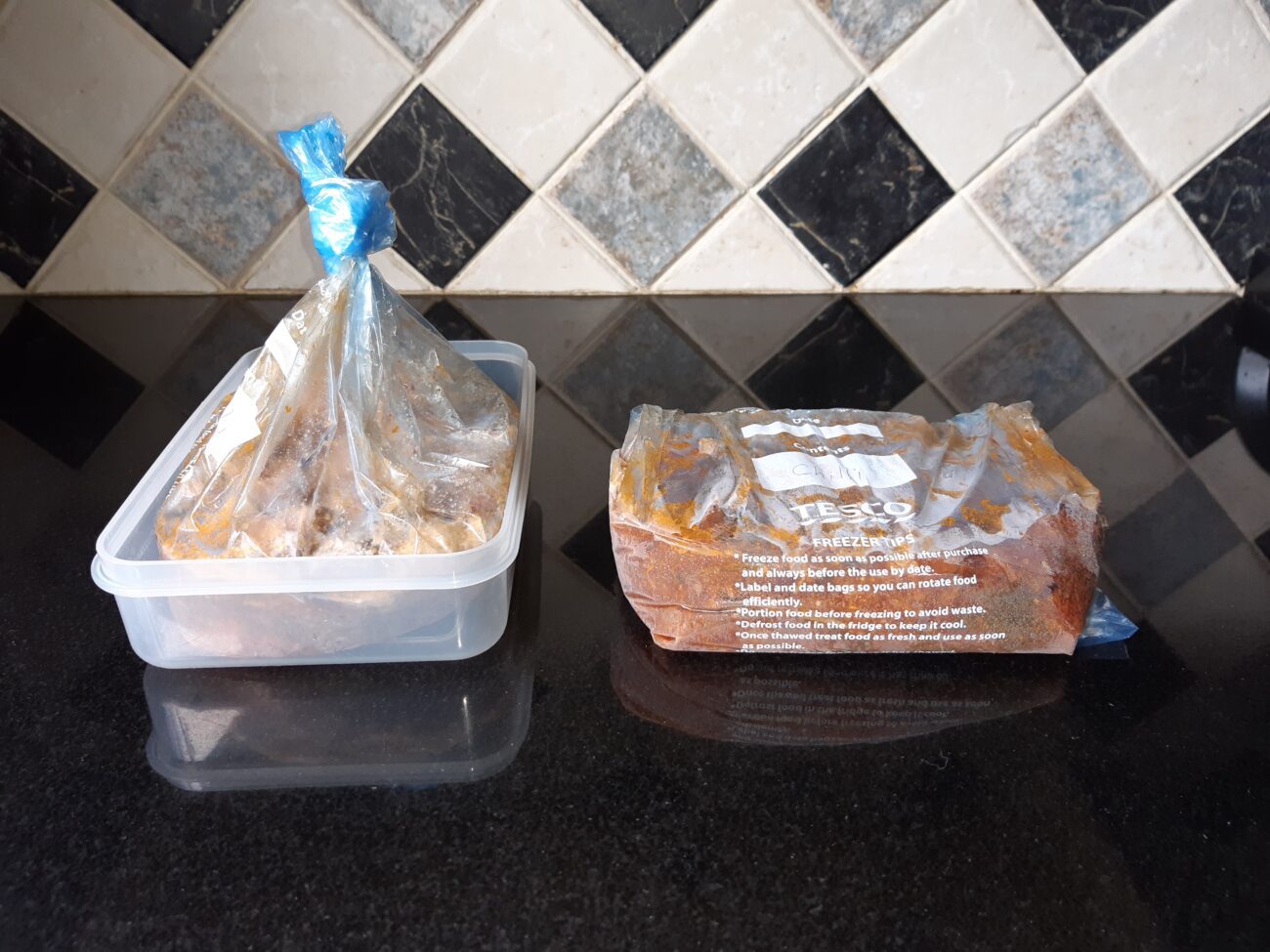

A few more helpful tips:
- Store ice-cream towards the back of the freezer to avoid freezer burn.
- Divide up bulk buy items – buying 20 chicken breasts for less than a five pounds is a bargain but it’s doubtful you’ll need all twenty at once, split them up into bags reflecting the number of people you cook for.
- Freezers work better when they’re full – Yes, believe it or not filling your freezer is good. Filling your freezer means it does not have to work as hard so puts less strain on the appliance.
- And most importantly – LABEL EVERYTHING. We don’t want to find anymore ‘things’ lurking behind the peas. When you go to freeze something write on the bag or box what it is and the date.
How Busy Lives! can support you with this
Busy Lives! was created when I left a busy career which left me time poor and unable to give appropriate priority to what really mattered to me. I have provided services like these for the self-employed, retired and for people with highly demanding careers.
I am happy to help with organisational support including optimising the space and storage you already have in your home. You can go out to work and return with the chaos sorted!
I can help by:
- Effectively organising your contents so regularly used items are readily and easily available.
- Organising any room in the house such as your kitchen.
- Re-organising cupboards and wardrobes which need attention.
- Making the most of the space and storage you have or would like to improve.
- Tackling that room, shed or garage which has become ‘the sort later room’ (the one that started as a drawer and became a room!)
Find out more about how I can help you with home organisation
Let you help you gain precious time back. Ring Busy Lives! 07565 722 031
Or Email: karen@busylivesnottingham.co.uk


Apr 21, 2020 | HOME & HOLIDAYS
Organising your household paperwork
Many of us have busy lives in one way or another, but perhaps sometimes we make ourselves busy as an excuse not to do those tasks we really don’t like or know where to start. The vast majority of people have something that they are always going to get around to or have something that gets transferred from one weeks ‘To do’ list to the next! Organising your home paperwork is a great example of this and yet it’s probably the most important set of papers you need to have at hand, safe and secure. This blog post shares a quick, easy process and system to help you put an end to having papers you can’t find, lying around or getting lost amongst all those other papers shoved in a box or kitchen draw.
Overview
-
Finding a system that will work for you and the people in you live with (Hd3)
-
Retention of paperwork
-
How and where to start if your paperwork piles go back years
-
Suggested ways forward for storing your household paperwork
-
Action needed / To do pile
-
Passwords
-
Becoming paperless
-
How Busy Lives! can support you
Please note: If you have less than a couple of years paperwork to sort, you may wish to skip section three.
-
Finding a system that will work for you and the people in you live with
You should never feel embarrassed if you have paperwork hidden away somewhere or shoved in a box! If you haven’t got a system that works for YOU it isn’t going to work and more importantly you won’t be able to maintain it over time.
What you need is a system in place that’s quick and easy to access it for YOU. Keep this in mind when reading and considering the rest of this content.
The other factor which is important to consider is who else needs to access and maintain your household paperwork. If it’s others in your household in addition to you, I highly recommend you discuss the different ways forward and agree on which system will work for everyone involved. The consequence of not doing this is you either end up back at square one will piles of papers dumped in a mess or you’re the one that always ends up doing the filing into the system!
-
Retention of paperwork
How long paperwork is kept and stored for has reduced over time in some instances. Much more household paperwork now available electronically, Section 7 of this blog post goes into more detail about electronic storage for this.
Important paperwork to keep and not destroy:
- Bank / Credit Card Statements – Keep the original joining information and then the last 3 or 6 months depending on your preference.
- Car Documentation – For the current car/s owned by the household. This should be the registration certificate. I also keep the purchase or lease agreement. It is useful to have a printed copy of your latest insurance certificate including your no claims bonus as if you change insurance companies many still request proof of no claims bonus. I also keep records of services and work carried out whilst owning the car as proof that it has been well maintained when selling.
- Certificates – Birth certificates / Marriage or Civil Partnership certificates / Exam and qualification certificates.
- Memberships – Such as for a gym, keep the original as it will have your number on it.
- Medical Information – Medical information worth retaining includes your NHS number, European Health Insurance Card, Vaccination record all need to be kept. If you have any medical condition records that would be important for a physician to know keep. Latest glasses prescription is useful to keep. Letters or cards of previous doctor or hospital appointments can be shredded.
- Mortgage & Life Assurance – Paperwork and any signed agreements relating to this. If you’ve paid off your mortgage it’s important to keep the Deeds and original survey you had when you purchased your property.
- National Insurance – Depending on your age this will either be on a piece of paper or card. You need to keep this.
- Savings information & Certificates – Keep the original information and statement/s showing the last six months. If you have Premium Bonds ensure you keep the certificate somewhere safe.
- Pensions – Keep the annual statements. This is especially important if you change jobs and have more than one pension in place.
- Pet – Keep details of their birth documentation / adoption, Microchip number and vaccination records
- Receipts, Warranties & Manuals – I keep receipts on any purchases more than the excess on my home insurance as a rule of thumb. Warranties speak for themselves, there’s no point keeping them if they have expired. Manuals tend to be for appliances and are worth hanging onto, especially the boiler one!
- Stock and Shares – Paperwork can be quite frequent so I suggest you keep your original statement, the latest one, then one from either every six months or year.
- Utility Bills – Keep the original joining information and then the last 3 or 6 months depending on your preference. If it’s an annual statement such as water rates, council tax or TV licence it’s your choice again if you just keep the current one or last three years.
- Wages & Tax Statements – I keep all my P45 & P60’s for tax purposes. This is especially useful if you change jobs and have been placed on the wrong tax code by HRMC. In terms of wage slips I suggest you keep the last six months. Large employers have large numbers salaries to cross check each month and mistakes can be made by error occasionally.
- Will & Last testament / Power of Attorney – Really important to keep the final signed copies of these. Draft copies can be shredded.
-
How and where to start if your paperwork piles go back years
If you’ve accumulated more than a couple of years’ worth of paper hidden in various different places you need a strategy to help you make a start and move forward. This isn’t a procedure to rush as it may result in you recycling papers such as those listed above which you need to keep.
Step 1
- Have a clear space next to your pile of papers – a table, the floor, or a kitchen worktop are the best ones.
- Get either three pieces of paper or post-it notes and write the following three words on as large as possible:
- Keep / Need to organise
- Recycle
- Shred
Important
Anything with personal information on about you or your family needs to be shredded. It’s far too easy for someone to steal your identity from your recycle dustbin . If you don’t have access to a shredder ask your family or friends if they have one you can borrow.
- Look carefully at each of your papers and place just under the appropriate label you’ve just made.
- This may seem a daft tip but go and put the recycle pile of papers straight in the bin! You’ve decided to recycle it, so do it!
- Shred pile of papers. Either sit and shred straight away so it’s done or put in a plastic bag and write Shred on the bag. Think carefully where you then put the bag, as you don’t want to find it in a few years’ time when you’re having another tidy!
Step 2
- Again start with a clear surface next to your ‘Keep / Need to organise pile.’
- Using blank pieces of paper or post-it notes write the new headings on each piece as large as possible:
-
- Bank, Savings, Portfolio’s & Loans
- Car & Bicycle Details
- Certificates & Passports
- Children / Pets
- House related & Bills
- Job related, Pension & Wage Slips
- Legal Power of Attorney & Will & Last testament
- Medical & Health
- Mortgage & Life Assurance
- Purchases, Receipts & Warranties
- Look carefully at each of your papers and place just under the appropriate label you’ve just made.
- Repeat this until your unorganised pile has diminished. You now have ten clear areas where your paperwork relates to a common theme.
Top tip
If you find you’re running out of time and need the surface for another use such as cooking the dinner! Carefully stack each pile on top of each other either inserting a coloured piece of paper / newspaper or silver foil in between each section. This will save you time starting from scratch again the next time you continue.
Step 3
- Take one of your ten areas at a time (i.e. Bank, Savings, Portfolio’s & Loans) and repeat Step 1 again, this time paying more attention to the date of the documentation when considering if it needs to be retained.
- Next, again with each area, sub-divide it further into sub-sections. For example:
- Bank Account
- Access Account
- Joint Account
- Bank Loan
- Savings Account
- Stocks & Shares
Top Tip
For each sub-section always have the latest date on the top. This makes it easier and quicker for filing new paperwork.
Step 4

- Purchase 10 folders. If possible use hardback ones as opposed to the flexible plastic ones. This stops all the folders collapsing like dominoes when you pull one out when filing a new piece of paper.
- Each of your 10 areas from Step 2 above now becomes the label you write down the spine of each folder.
- Using either file dividers or plastic wallets with a piece of coloured paper in, now insert your organised papers from that pile into sections into your folder.
Top Tip
Have an A4 Hole puncher with the pull-out arm set for A4 paper near to your folders. This makes it always quick and simple to file new paperwork straight away as opposed to dumping it and creating a disorganised pile again.
-
Suggested ways forward for storing your household paperwork
We are spoilt really with the different types of storage now available on the market. What I would stress here when deciding what to buy, is to reflect on which system is going to work efficiently, quickly and easiest for you. To some extent it may also depend in the amount of space you have in your home.
These are my top three:
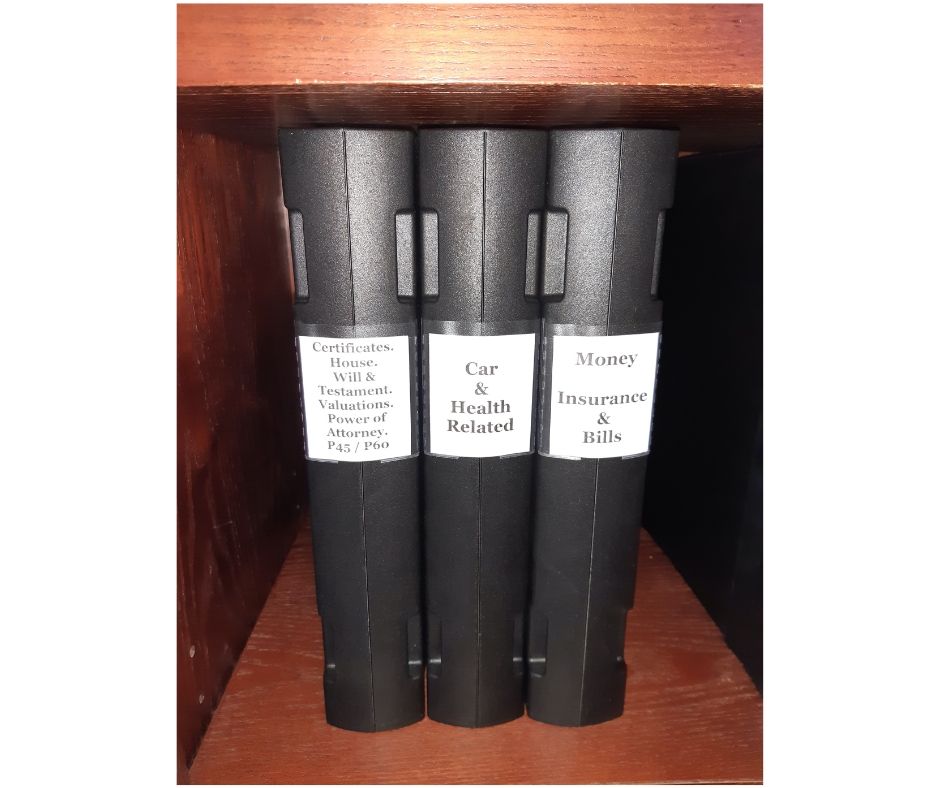
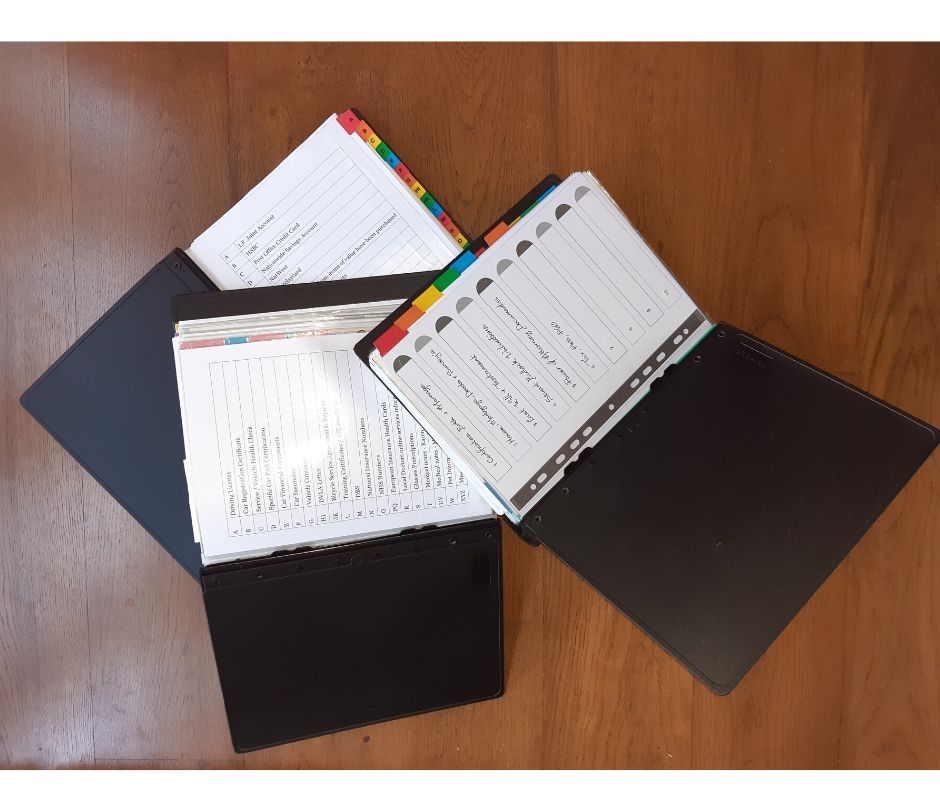
-
Hard back Ergogrip Binder
+ Hardback durable folders which stand up on their own without needing support on your shelf looking professional and smart. Very quick and easy to file new paperwork into the sub-sections you create. I’ve recently reduced my ten folders down to three – the secret of course being clearly labelled file dividers.
– Quite expensive compared to other folders on the market you can buy.
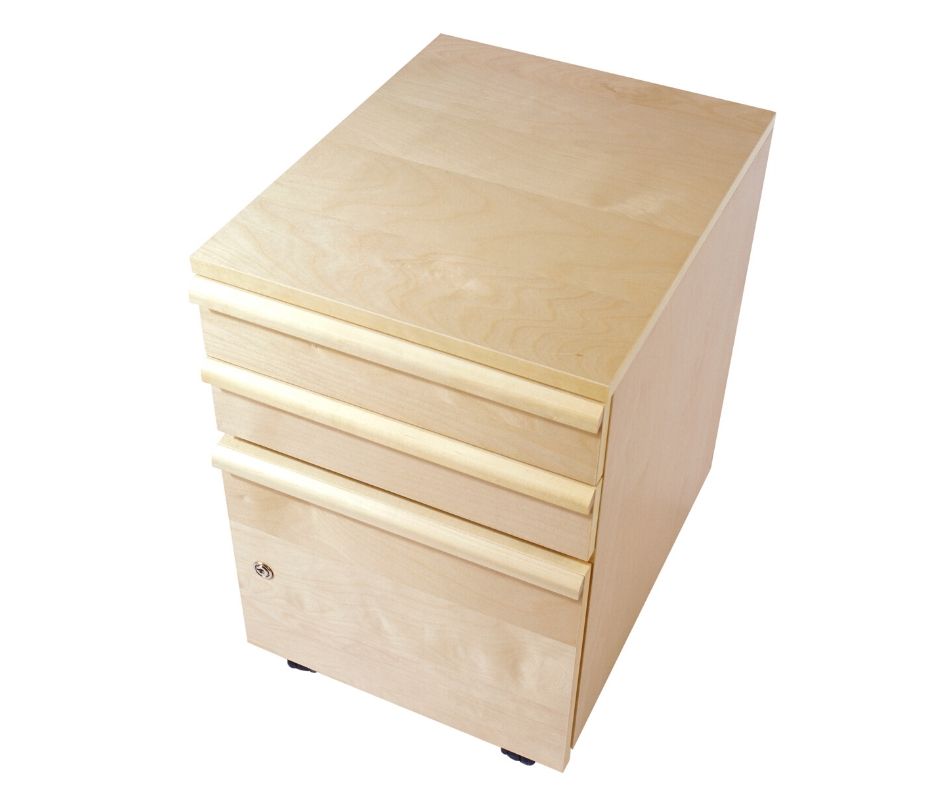
-
Under desk small filing pedestal cabinet
+ Can fit under your desk or at the side blending into your chosen colour scheme as they come in a range of wood and spray paint finishes. They also come with 2 width options which is good if you’re short on space. Paperwork goes in the bottom drawer, with middle draw useful for storing paper / plastic wallets and the top drawer your stationary.
– Can be a disaster if you don’t buy the correct file dividers and label them correctly.
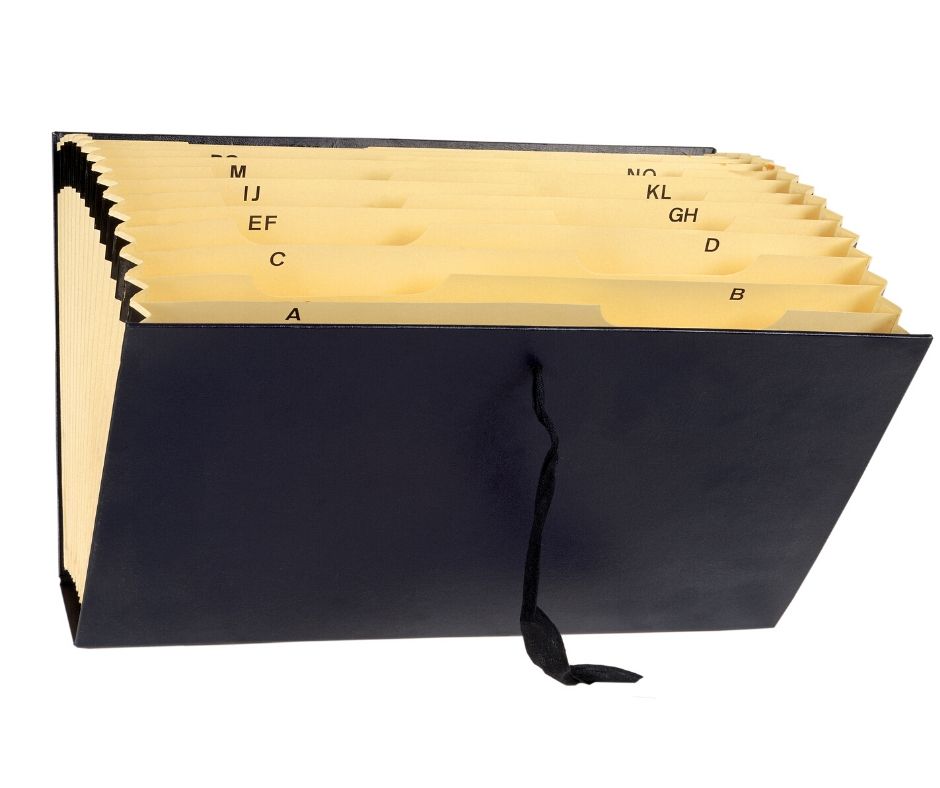
-
Concertina Folder
+ Quickest and easiest for filing new paperwork as it comes in if you have the sections clearly labelled.
– Avoid buying a cheap cardboard one as with the volume of papers going into it there tend to tear. If you file everything alphabetically as some are labels you end up with some sections not able to hold everything within it. Write your own headings on if you go for this.
Top Tip
File new paperwork once dealt with as it arrives if possible. Have a system with bills etc that when a new one goes in the last one comes out and gets either recycled or shredded depending on its content.
-
The Action Needed / to do pile
Some new paperwork as it comes through the post will need acting upon. The danger here is if you file it straight away you forget to action it or if you leave it lying around it gets lost. I simply use a brightly coloured document wallet in put the papers needing action in there – this works really well and as soon as I’ve carried out what was needed I file the paper accordingly or recycle/shred if no longer needed.
-
Passwords
We all have so many different important passwords for things which we’re meant to be able to memorise. The most important thing if you can’t like me remember them is to never store them in the same place as your paperwork and in a different location. If you do have them written down in a book ensure this is stored somewhere safe and if possible with locked access.
A second place where you can store them is your phone but I wouldn’t recommend that unless you have a tight level of security on it in addition to 2-factor-authenication when switching it on.
The best place for storing passwords is in an electronic online password manager programme such as ‘LastPass.’
-
Becoming paperless
Many homes are becoming ‘paperless’ and save everything electronically. Some paperwork some as bank statements can be accessed automatically online so that you no longer need paper copies. Other documentation still comes through the post. The way around this is to invest in a scanner, many printers come with them now and are easy to use.
Top Tip
If you do decide to become paperless and save all you paperwork electronically create the same folders and sub-folders as you would have done with a physical folder and label each document carefully including the year.
Important
I would highly recommend you don’t do this if you have not got a high level of security, anti-virus and back up on your machine and it’s storage. If all these are in place you’re away!
-
How Busy Lives! can support you
Busy Lives! was created when I left a busy career which left me time poor and unable to give appropriate priority to what really mattered to me. I have provided services like these for the self-employed, retired and for people with highly demanding careers.
I am happy to help with organisational support including optimising the space and storage you already have in your home.
You can go out to work and return with the chaos sorted! Why not let me make it easier to find what you want straight away throughout your home from that important document to your favourite items of clothing.
This work focuses on the logistical re-organisation of any existing storage used in any part of the home, together with the creation of new storage and filing systems where needed, so that space is optimised, and you can access what you need in a systematic and orderly manner.
Small business owners who work from home may have different needs can help with, such as setting up your home office with a manageable filing system to assist you.
I can help by:
- Design a system that will work for you with how you store and stay on top of your paperwork.
- Create clear and effective filing systems for your household utilities and other home documents.
- Provide the additional option for me to revisit on a quarterly basis to file new papers and maintain your system.
- Enabling you to become paperless if you have the proper securities in place electronically by scanning, creating and saving your electronic home paperwork systematically on your behalf.
- Setting an excel document up to track your household income and expenditure on a monthly and annual basis.
Find out more about how I can help you with wider aspects of home organisation
Let you help you gain precious time back. Ring Busy Lives! 07565 722 031


Mar 21, 2020 | FINANCE
Preparing for the New Financial Year
Unless you use one of the accounting software packages that takes and uploads the photographs of all your expenditure receipts and invoices, you are still required by HRMC to keep paper records of all these for 6 years. This is regardless if you are a Sole Trader or Limited Company. In this blog post I share how I organise my paperwork for this and also keep track of everything financially on Microsoft Excel.
Receipts more than your invoices tend to make the most mess or get lost! They are all different sizes and find their way into your pockets or bag at random times. The main reason they get ‘shoved’ somewhere impractical is that there isn’t an easy system in place to file them effectively.
Likewise with paperwork, if there isn’t a system in place that’s easy to access it often just goes in a pile of other papers you have which becomes lost, thrown or shoved in a draw as you don’t know where to put it.
What follows is a simple and quick way to stay on top of your business financial filing.
Overview
-
What you need
-
Setting up for your folder New Financial Year
-
Setting up excel to track your income and expenditure for the New Financial Year
-
The way this now works
-
How Busy Lives! can support you with this
-
What you need
You just need four items to gather and you’re set up for the year ahead.
- 1 x A4 Lever Arch folder
- 2 x File Dividers labelled by month
- 12 x A4 Plastic wallets
- 2 x Sheet of bright A4 coloured paper or card
What are the best A4 folders to use?

The type of folder you buy can really make a difference. To a certain extent it will depend on your budget as they range from £2.00 up to £30.00. The most important consideration when purchasing any is to open and close the lever arch mechanism a couple of times and check it closes correctly. If it looks anything like the picture here avoid, as when you go to turn to a specific month all the contents will either become stuck or fall out.
 I often get asked which are the best A4 folders to buy. In terms of the clasp mechanism I would definitely go for an ‘Ergogrip Binder’ as it is the best one I’ve come across for durability and also stays in place on your shelf looking professional and smart.
I often get asked which are the best A4 folders to buy. In terms of the clasp mechanism I would definitely go for an ‘Ergogrip Binder’ as it is the best one I’ve come across for durability and also stays in place on your shelf looking professional and smart.
In terms of Lever Arch, go for one which is a thick PVC which will stand up on its own without falling over. I also like to be able to insert my own label down the spine so that I can update it when it has a new use, without the folder becoming ‘scruffy’ to the eye with writing scrubbed out and new titles written.
What are the best file dividers to use?
There are many types of file divider on the market. Try to avoid the paper ones if possible as they don’t tend to wear well when the folder is used frequently. My preference are these A4 Monthly ones which have a reinforced tab and hole punch spine. They always look as good as when you purchased them and you’re not having to count the months every time like the 1 -12 file dividers to remember which financial month you’re in!
Setting up for your folder New Financial Year
- With one of your sets of file dividers place an A4 plastic wallet after each month in your folder.
- Insert the mixed file dividers and wallets into your folder commencing with April on top and the last three months of the financial year after December.
- Put your coloured card or paper in a plastic wallet on top of this in your folder. You can also print Expenditure on the paper / card if you wish.
- Now put your second set of file dividers on top of this. Again start with April at the top.
- Put your coloured card / paper in a plastic wallet on top of this in your folder. You can also print Income on the paper / card if you wish.
The way this now works

 Income Section – This top section of your folder can now be used for inserting and filing invoices you send each month. I always put the latest dated invoice on top within each month.
Income Section – This top section of your folder can now be used for inserting and filing invoices you send each month. I always put the latest dated invoice on top within each month.
Expenditure Section – File your expenditure invoices within the month of your order, again with the latest date at the top.
Receipts from that month simply go in the plastic wallet behind your invoices.
Top Tip
If you also like to tack both your income and expenditure on excel this is a quick and simple way to ensure you’ve entered everything. I simply highlight the date on invoices and receipts after I’ve entered them onto my excel spreadsheet. Easy and quick cross check!
Setting up excel to track your income and expenditure for the New Financial Year
There are some brilliant digital financial packages out there such as: Zero and QuickBooks. I highly recommend you speak to your accountant as to which package would suit you and your business. If the size of your business doesn’t warrant this and you still use excel to track your income and expenditure you may find the following useful.
Create and name the following sheets giving them a tab colour if you wish:
- Annual Expenditure
- 12 Month Cash Forecast
- Expenditure
- Car Related
- Bank Statements
- Income Invoices
- Client Analysis
- Thank you
The Pictures below show how each of the pages is then set up:


Top Tip
If you are really busy with client work find a regular time each week / month when you can update it.
Alternatively, update the sheet after you send a batch of invoices out to clients or have cross checked against your bank statement for when the money went into the bank.
-
How Busy Lives! can support you with this
Busy Lives! was created when I left a busy career that left me time poor and not able to give sufficient priority to what really mattered to me. I provide services like these for local small businesses and this frees up their time to focus on bringing in greater income for their own business. A ‘win-win!’
I am happy to help by:
- Setting up your financial folders.
- Filing your paperwork and receipts keeping your folders up to date.
- Showing and teaching you how to use excel to manage your finances.
- Letting you have a copy of the excel finance master I’ve created and use with my business.
- Dealing with your invoices, bills and reconcilliation on QuickBooks or Zero on either a weekly or monthly basis.
Let you help you gain precious time back. Ring Busy Lives! 07565 722 031
Drop me a message on LinkedIn / Messenger on Facebook
Or Email: karen@busylivesnottingham.co.uk










 Home to your milk, cheese, fruit, veg and meat the fridge is arguably one of the most important appliances in your kitchen. So, let’s show it some love.
Home to your milk, cheese, fruit, veg and meat the fridge is arguably one of the most important appliances in your kitchen. So, let’s show it some love.










 I often get asked which are the best A4 folders to buy. In terms of the clasp mechanism I would definitely go for an ‘Ergogrip Binder’ as it is the best one I’ve come across for durability and also stays in place on your shelf looking professional and smart.
I often get asked which are the best A4 folders to buy. In terms of the clasp mechanism I would definitely go for an ‘Ergogrip Binder’ as it is the best one I’ve come across for durability and also stays in place on your shelf looking professional and smart.

 Income Section – This top section of your folder can now be used for inserting and filing invoices you send each month. I always put the latest dated invoice on top within each month.
Income Section – This top section of your folder can now be used for inserting and filing invoices you send each month. I always put the latest dated invoice on top within each month.


